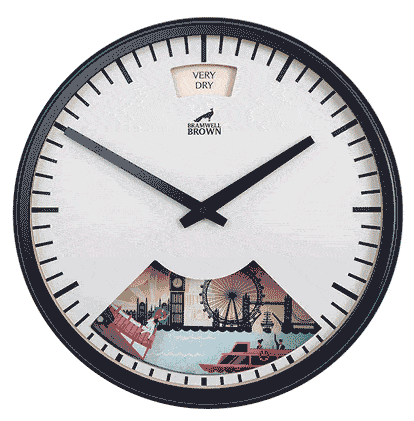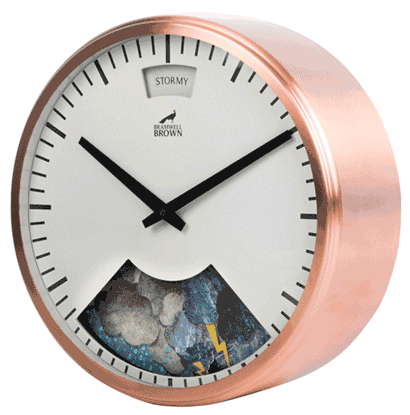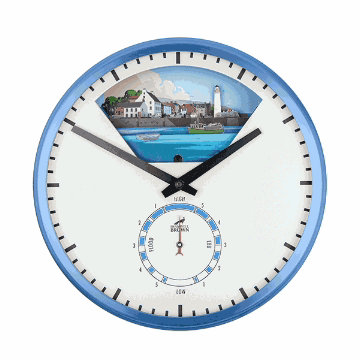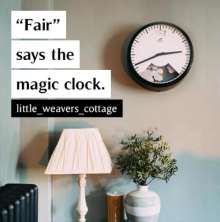The Bramwell Brown Blog
How Big Should a Wall Clock Be
It’s sometimes an unfortunate reality that we find a clock that we absolutely adore, only to be concerned that it’s possibly either too big or too small for the space that we want to put it in. Before getting to that stage in clock-shopping, it’s a good idea to figure out what size clock you should be looking for to fit the space that you’re trying to fill.
Though smaller wall clocks are ideal for function and tight spaces, you may be looking to have a larger clock that is beautiful enough to double as a work of art. While that doesn’t discredit small clocks that are ornate or artistic, they tend not to attract the eye as much as a larger clock that simply occupies more visual space. With that in mind, we consider when and where should you choose a big wall clock?
Fitting the Space
Although there is no magic ratio of wall space to clock, you’ll still want to assess the available space that you have and how much of it that you want to fill. If you’re getting an oversized clock as a statement piece, likely it should be the biggest thing on the wall, so it’s not competing for attention. You also don’t want visual clutter to detract from the beauty of your clock, and it’s a good idea to space out statement pieces across different walls, or better yet, different rooms. Each unique piece, art or otherwise, should stand alone in order to command the viewer’s attention and set the tone.
So ideally, you’re best in picking a more or less bare wall or clearing some space on your chosen wall. Once you’ve picked the wall you want to adorn, consider how much of a focal point it will become. A wall that is behind the main sitting area is probably not the best choice in terms of directing attention to the clock. A wall adjacent or in front of where you’re likely to be focused is a good choice as long as there is enough space.
Spots to consider hanging a clock would be above a mantle, near a desk in a study or in the home’s entryway. The ideal ratio for artwork on a wall is that it should cover about 2/3rds or 3/4ths of the wall space. Unless it’s a smaller wall, that’s quite a lot of space to cover, so think about accenting the clock with similarly themed work or cut the ratio down with your best judgement or with the help of an interior designer.
Size of the Clock
In this regard, size does matter and going too big or too small can make your walls look crowded and cluttered or too sparse and mismatched. Generally, a clock will be between six to eighteen inches (about 15 cm to 45 cm). A smaller clock might measure around 8.5 inches (21 cm), and a medium clock sits around 12 to 24 inches (30 to 60 cm), while a larger clock can be between 24 to 32 inches (60 to 81 cm).
In order to best decide on whether you should get a small, medium or large clock, you’ll want to consider the purpose. Is this clock for decor? Is it for function? While you can get away with a larger clock in a smaller space for an oversized look that draws attention to the clock as a focal piece in the room, you’ll want to avoid going too small in a big space. A clock that is too small looks underwhelming and can get lost in the decor or just look out of place.
Choose something that can sit comfortably at eye level and be read clearly from across the room as you’ll find that needing to get up close to the clock to see it can get annoying. Pick something that is large enough for you to read without straining from a distance and if you’re able, get some other impartial opinions on whether or not the clock makes for easy time telling.
When it comes to picking out a clock, there are some guidelines that you can follow for the size of the clock and the room it will be in. For a small clock, try picking one that has quieter mechanisms so that you’re not hearing a constant tick-tock sound. It should be battery-operated so you don’t need to attend to it until the batteries fail, in contrast to clocks that need regular winding. You’ll likely want clear Arabic or Roman numerals so that it’s easy to read on a smaller face. Be sure that it’s easy to hang, with a nail slot and that it’s not overly heavy since you likely won’t have too many options to reinforce the clock to handle its weight.
For medium-sized clocks, you might consider a style that is more contemporary that breaks away from traditional aesthetics. Here’s where you can choose fun and bold colours or wild designs since it’ll be big enough that you can still read the time from its face. Look at clocks you might not normally consider and see if it would add that “pop” to the room you intend to place it. You can err on the side of a heavier clock made with nontraditional materials like aluminium or composites. Picking something that’ll last a long time and has durable construction is a must if you plan on keeping the clock for a while. Think about a medium-sized clock for a bedroom, bathroom or living area.
A larger clock gives you the most opportunity for creativity, as these pieces function great as purposeful decor. These timepieces should be anything but plain and boring since they’ll be taking up a lot of wall space, they should flow with your decor and possibly be a statement piece. You can pick a clock with an easy-to-read face, but because of how large it is, you’ll likely find that it’s quite easy to read from a distance no matter how abstract or decorative it is. Handcrafted and frameless timepieces tend to dominate the world of larger clocks, and they bring style and charm into a home when hung or placed. They are great decor pieces for living spaces, kitchens and big hallways.
Hanging the Clock
Larger clocks generally weigh more, and that can make hanging them tricky. Trying to support its weight on the wall can be a challenge since the last thing you want is for the clock to give under its own weight and fall. There are a few ways to approach this task; while keeping in mind that your clock is likely fairly fragile as well.
1. Consider the wall. Drywall is not nearly as strong as stone or brick, yet there are quite a few options for all kinds of walls. Find any studs in the wall with a magnet or stud finder, and make sure to mount to the strongest point. With drywall, that means finding the wood support and using that as the spot to hang your clock.
2. Measure to find the spot you’d like to hang in. If you’re choosing the centre of the wall, this is a necessary step. Designate the point where your hanging fixture will go with a light pencil mark.
3. Go to a home hardware store and browse the selection of hanging screws. They should have the amount of weight that they can hold. Going up from that is a safe bet that your clock will be safe and stable.
4. Take a look at fastenings that are mounted to the wall with screws, or use an anchor that you can screw in that will cling to the backside of the wall. There are also hooks and picture cord that may help to evenly distribute the weight across more than one point.
5. Test the fastening by tugging downward on it either with your hand or a measure of string to ensure that it will hold your clock.
6. Avoid nails, as they’re likely not strong enough to carry the weight of an oversized clock and adhesive hooks run the risk of peeling off from the wall if not applied correctly.
Step back and admire your work and your new (or old) piece of art that has finally found its home. For the first week that your clock is up, you may want to double-check that fixture’s strength. If you’re able to take the clock down and inspect the hanging, do so to make sure nothing has moved, bent or weakened.
Recommended Reading: How to Choose a Wall Clock for Your Home
The Clock
Likely you already have your wonderful clock selected, but if you’re still looking for some inspiration, check out Bramwell Brown’s Large Weather Clock. It is quite impressive in a room at 53 centimetres, with the classic artistic animation of the weather on a bigger scale than the rest of our line. Free delivery is included, however because of the fragility of this beautiful clock, it will only ship within the UK and to certain postcodes.
If you’re shopping around for a medium-sized clock, take a look at Bramwell Brown Weather Clock line, including their limited edition clocks that feature scenes around London, backcountry wilderness and pilots of all kinds taking to the skies. In addition to the traditional Weather Clock, they carry a few other versions of their forecasting timepieces and they can be further personalised with a bespoke face or frame colour--making them an ideal present or commemorative gift for that milestone moment.
If you’ve already found the clock you’ll be hanging, make sure that you’re able to access it easily still if you ever need to change batteries or do light repair. The owner’s manual and warranty, if it should come with one, should be kept in a safe place. This is a great time to sit back and enjoy the new addition to your wall space, as a clock this large is a statement piece on its own.







